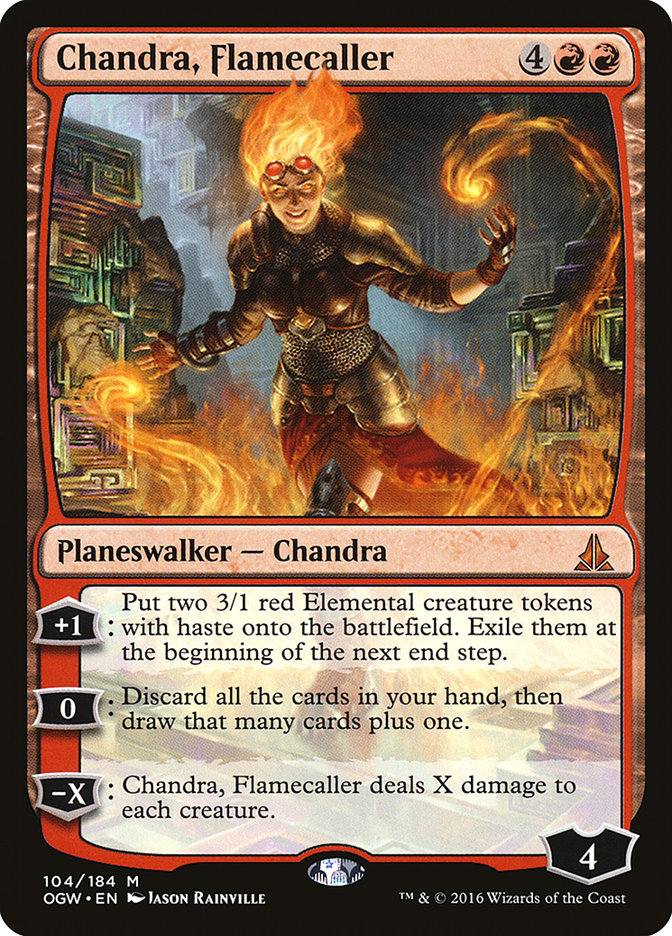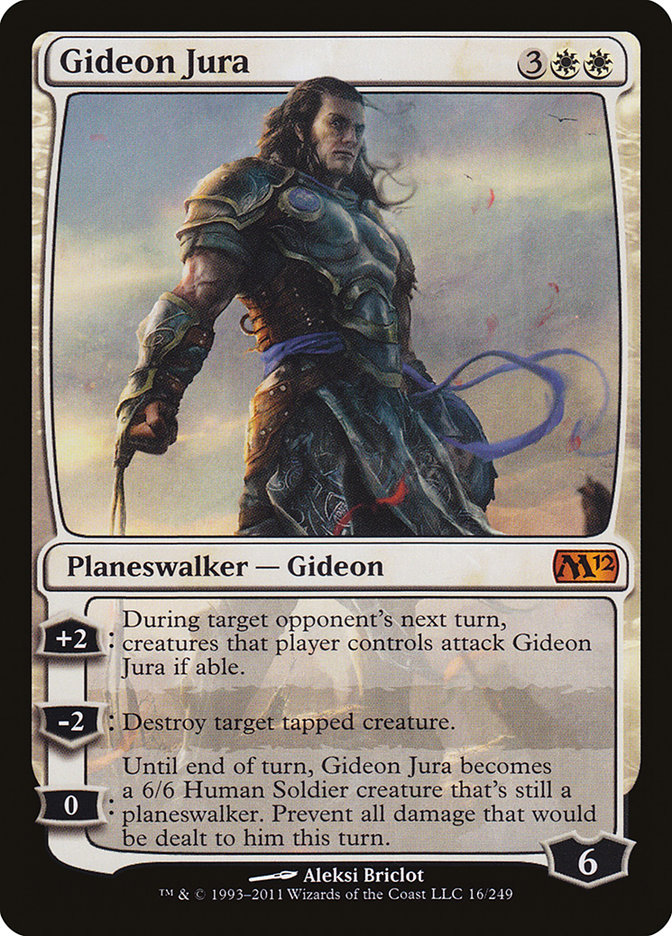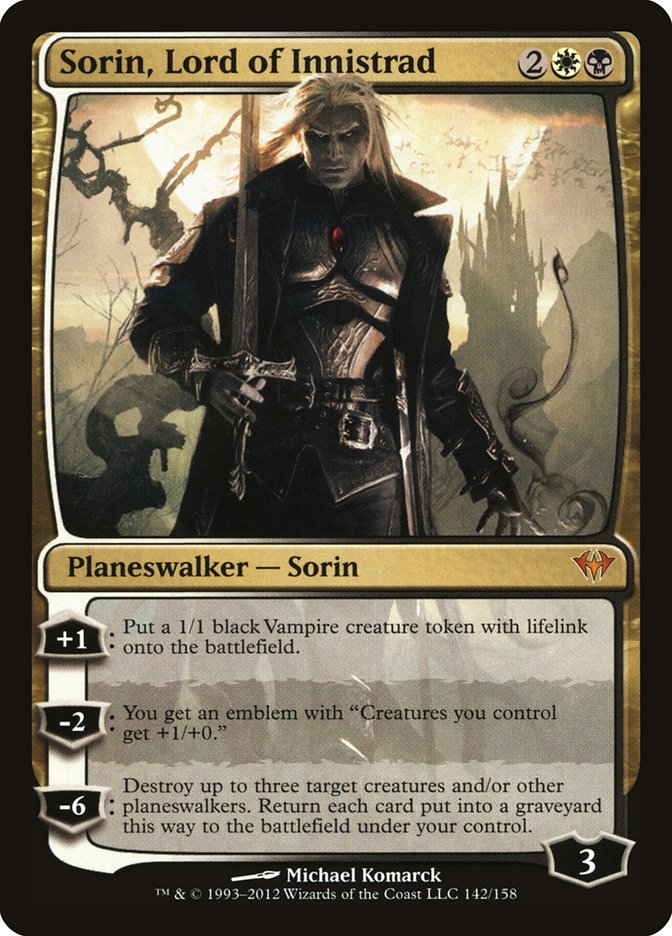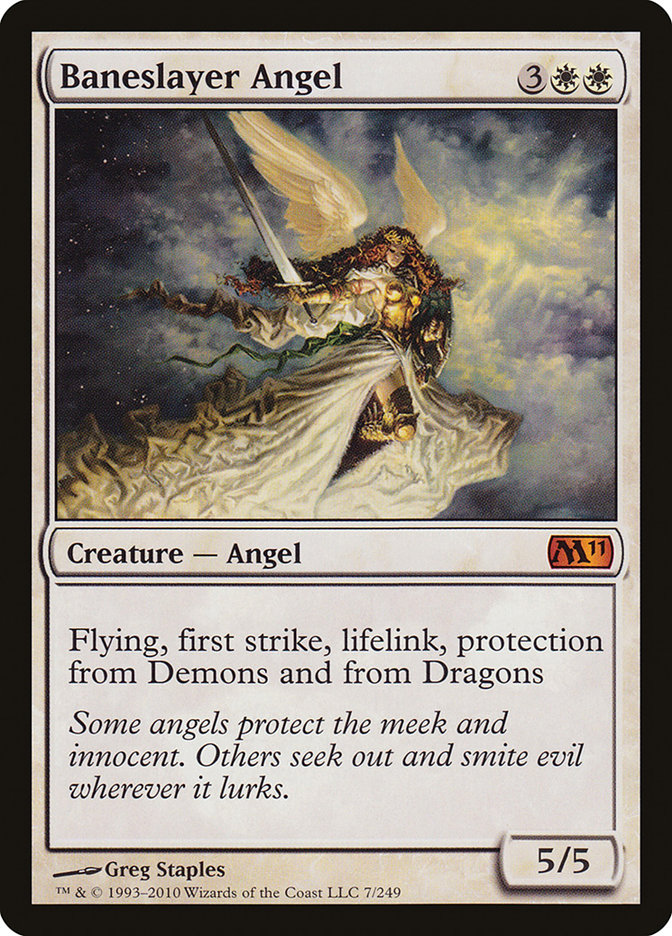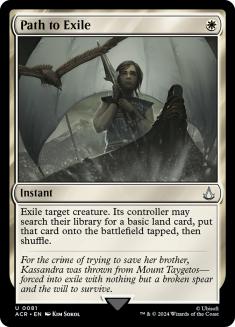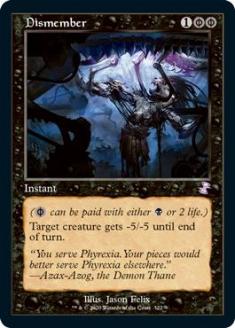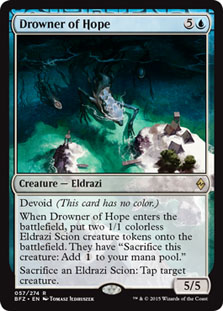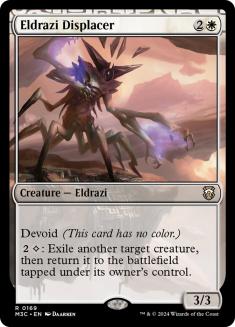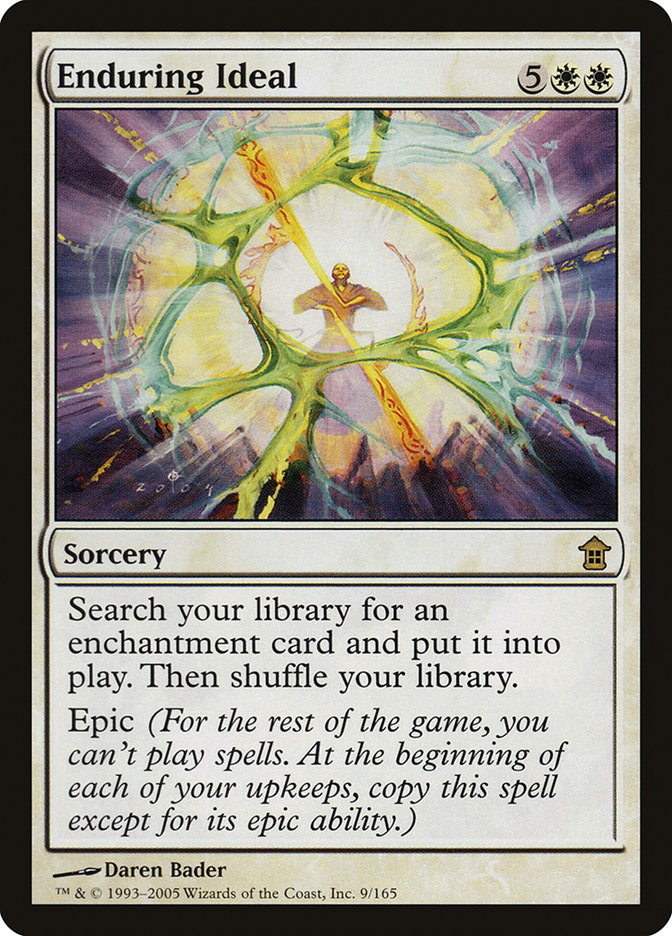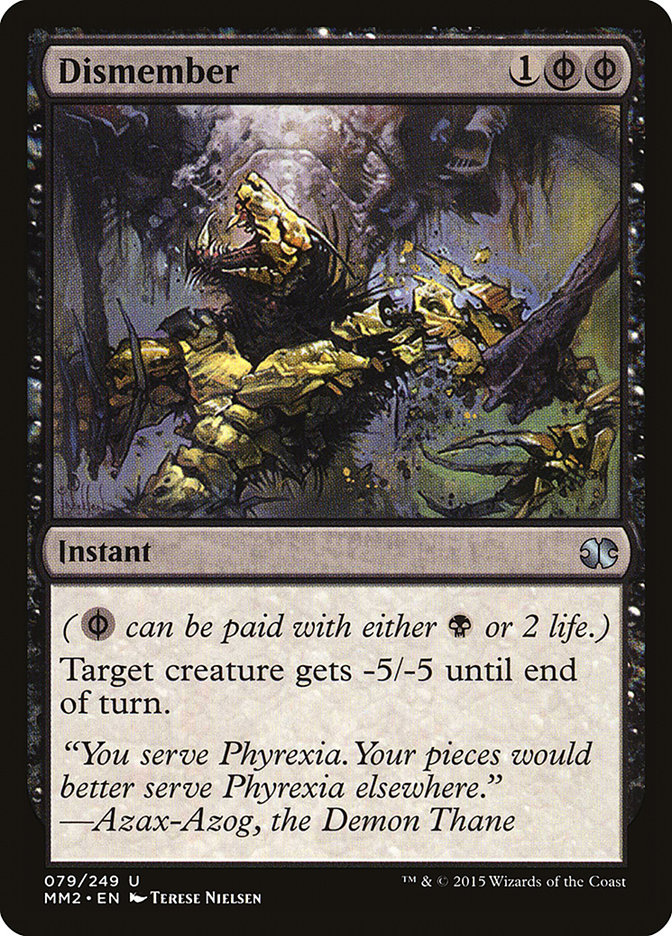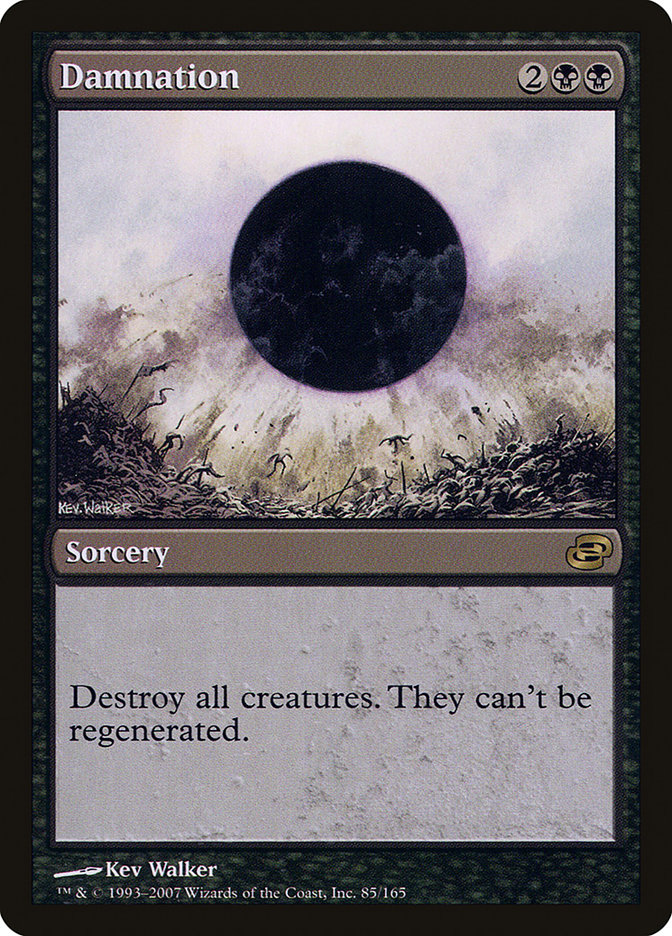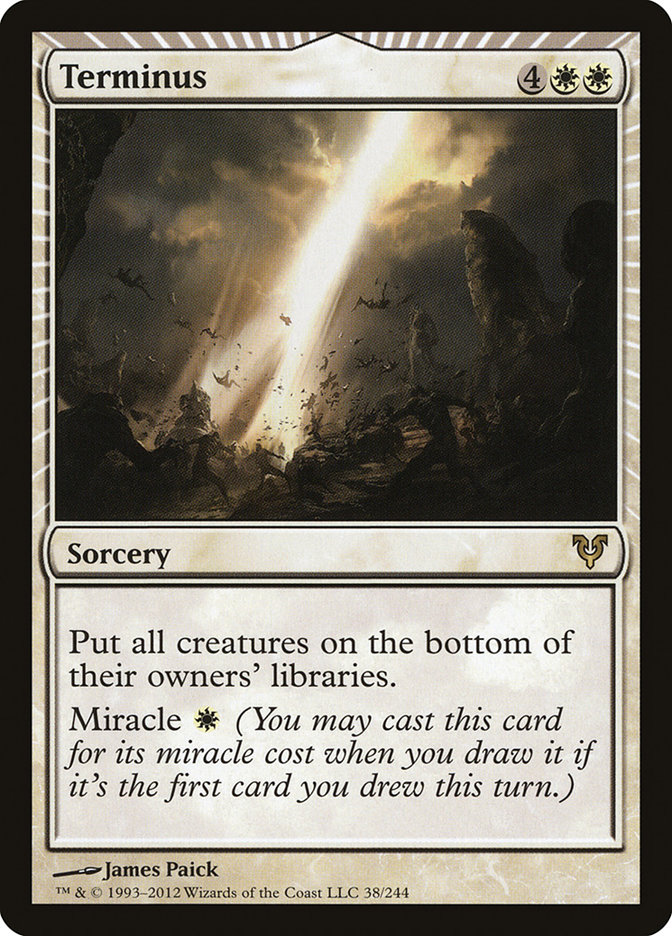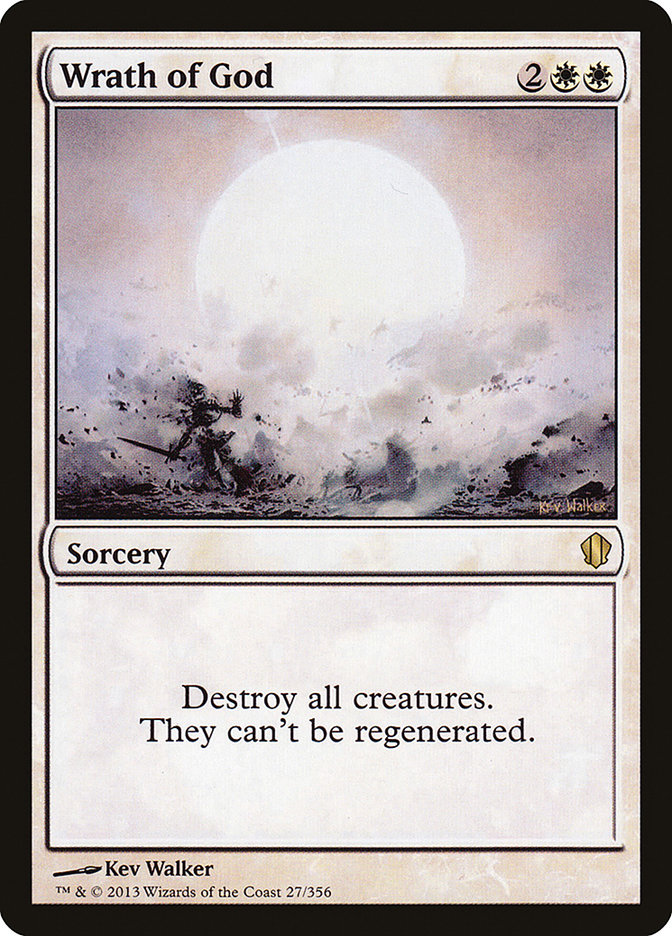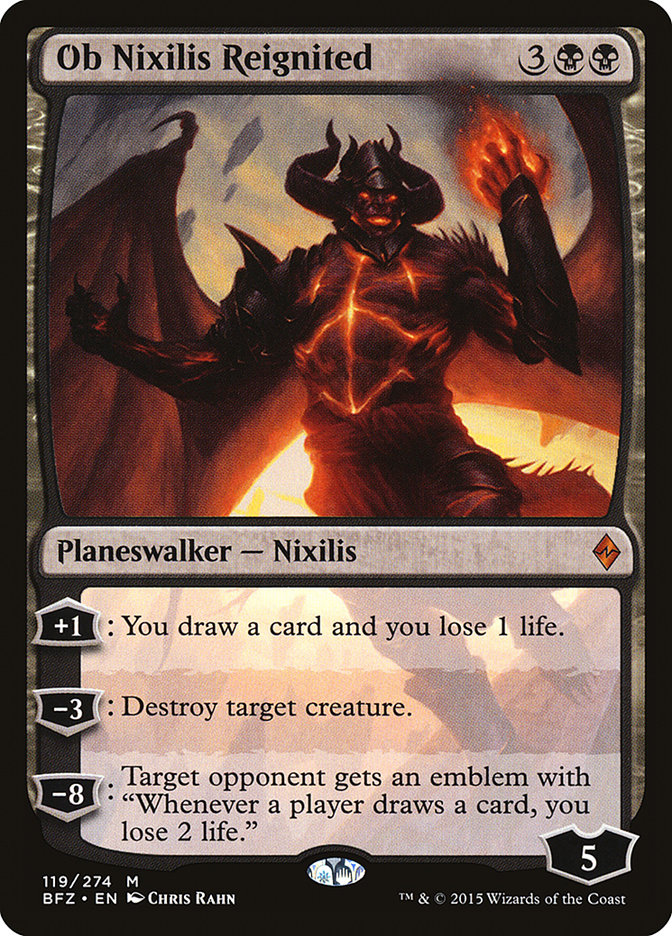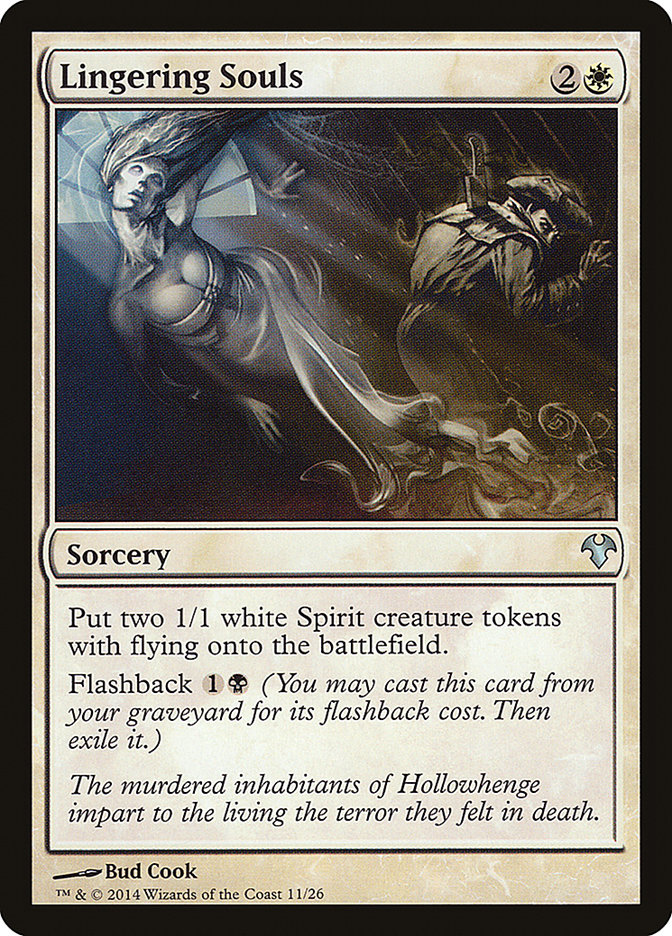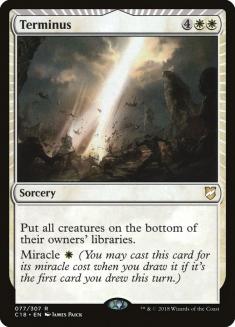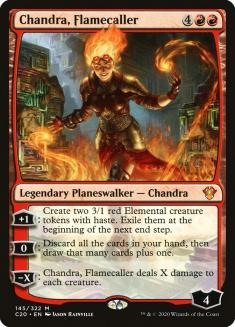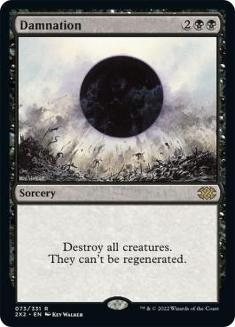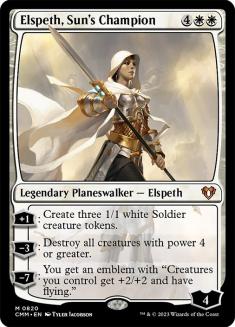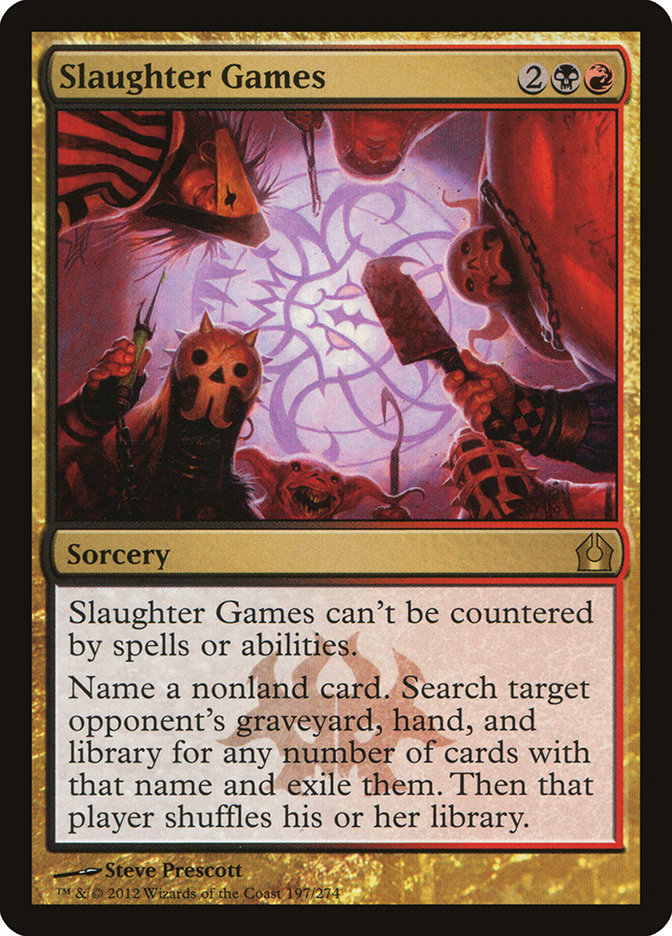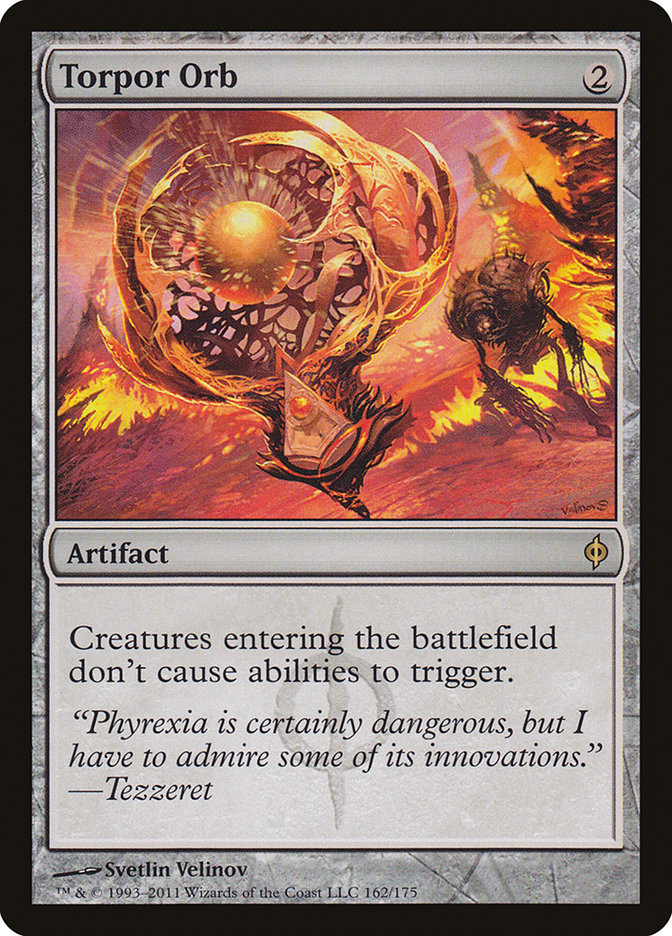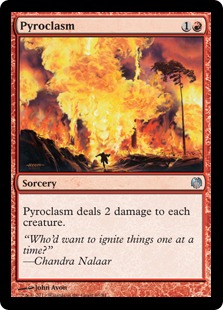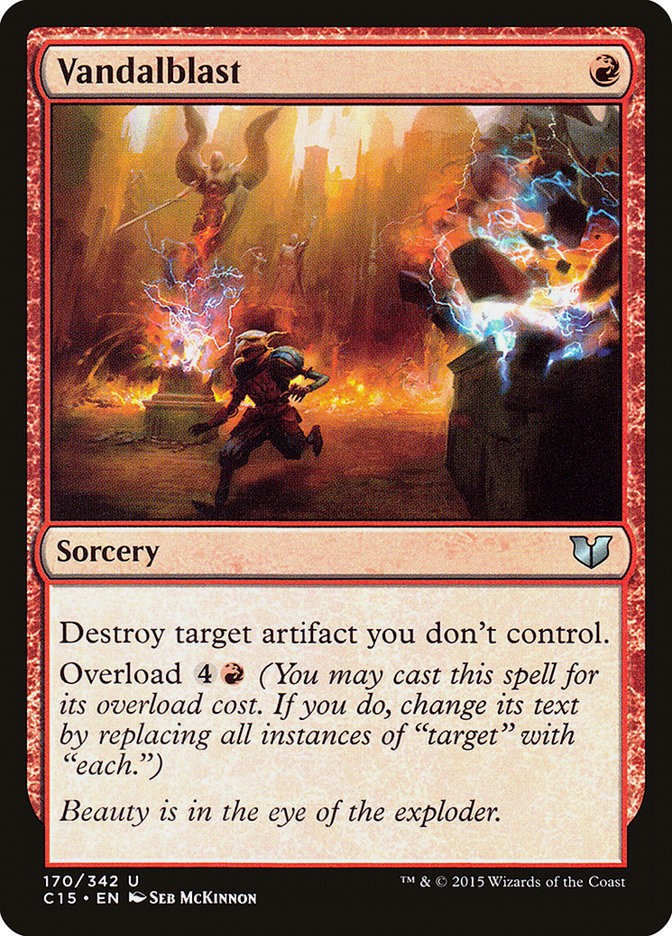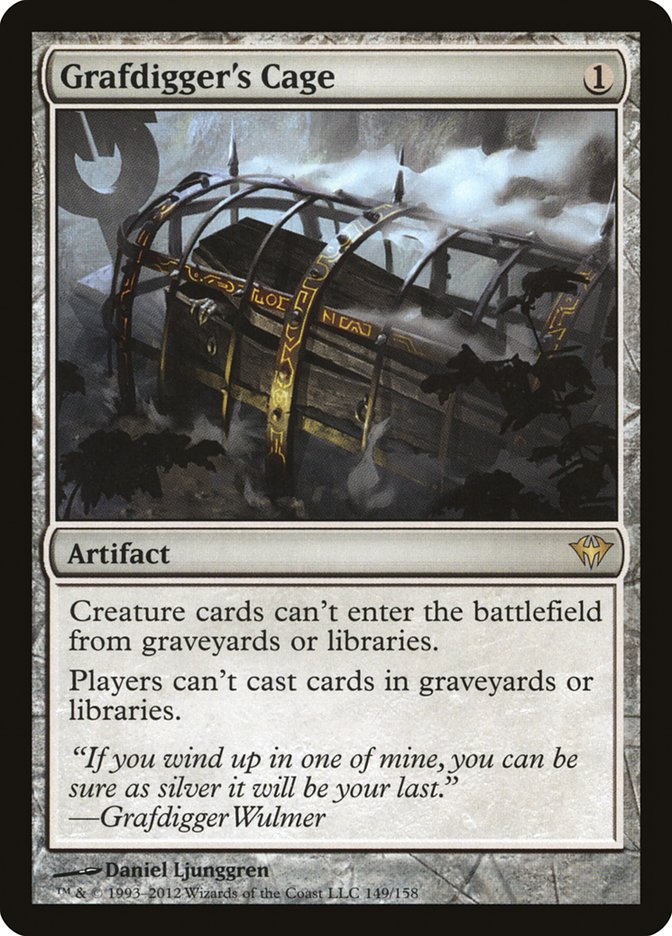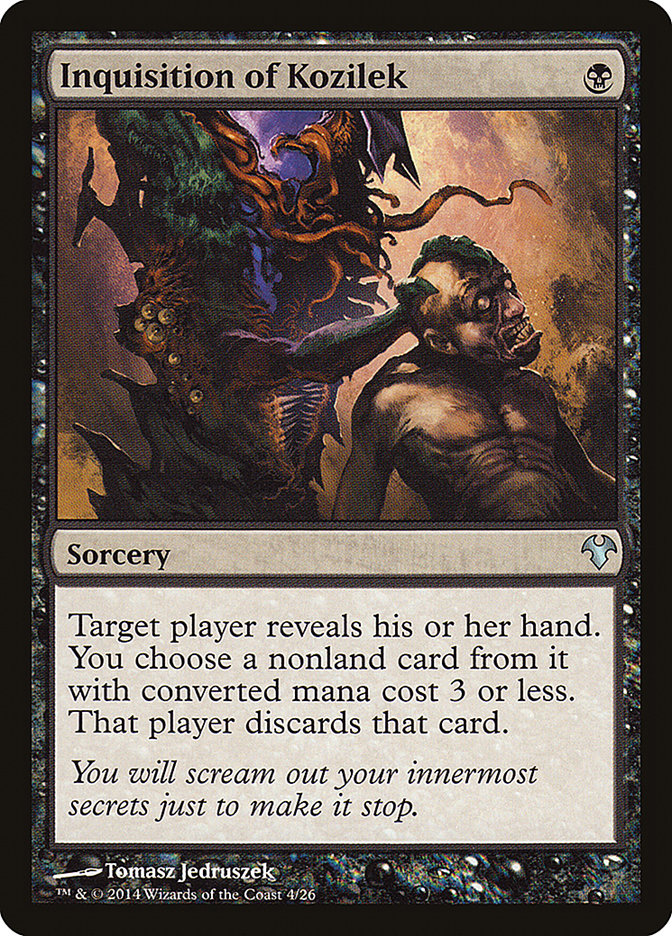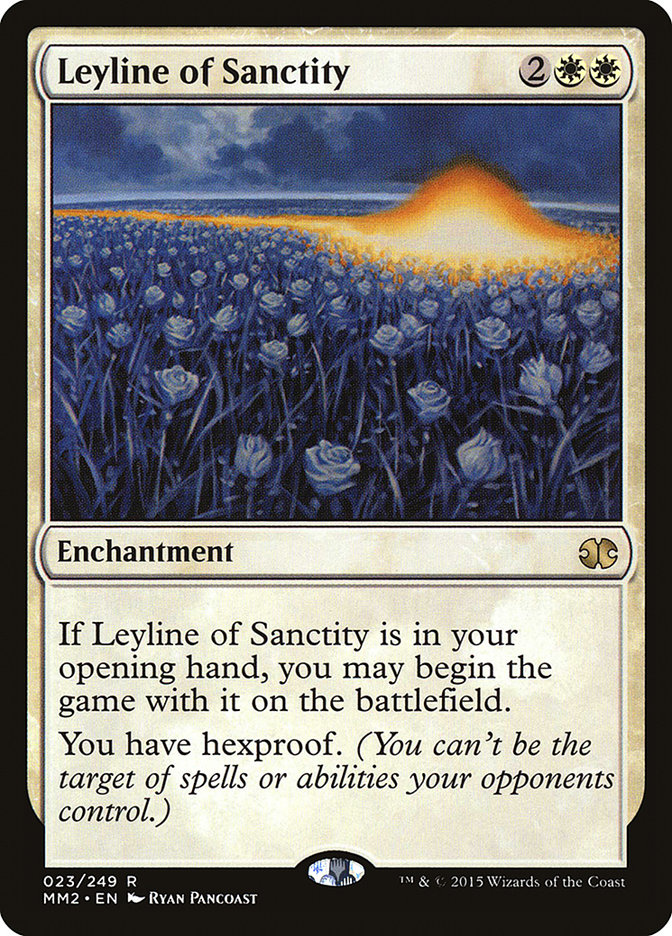When it came right down to it, I couldn’t pull the trigger on Eldrazi.
Friday night, I was interviewed by Brian David-Marshall about my deck choice, and he asked if I was fighting with or against the Eldrazi. Truth be told, I had two decks with me. One was an Eldrazi deck – one of the two Eldrazi decks I had practiced with – and the other was my “Wild & Free” freewheeling non-Eldrazi deck.
I made my final decision sometime during the rest of that evening.
My deck was pretty wild. I ended up at 10-5 with a single Pro Point as my reward.
I ran into Gavin Verhey during the event, and he asked what I was playing. I told him I was playing a kind of Mardu Planeswalkers deck. As he thumbed through it, Sam Black looked on and said, “Superfriends? These planeswalkers aren’t messing around! This is more like the Justice League!”
Here’s what I played:
Planeswalkers (10)
- 2 Gideon Jura
- 2 Karn Liberated
- 1 Sorin, Lord of Innistrad
- 2 Elspeth, Sun's Champion
- 3 Chandra, Flamecaller
Lands (25)
Spells (25)

The deck was basically about a day old when I registered it, but it was based on three or four decks that I’d been working on for between eight years and a few months. As I learned lessons in the Eldrazi Modern metagame, I kept altering what I was working on, attempting to adapt. More on this development in a bit…
The deck was imperfect to be sure, but it was a complete joy to play. This was, in fact, a huge part of why I chose to play the deck. I had been playing primarily U/W Eldrazi and R/G Eldrazi for the past few weeks, and my margins of victory versus other Eldrazi decks was basically no different than I had with this deck, so it seemed to me I should just hunker down and accept it. I liked what was going on with this deck, and I just needed to make the call. In the end, I’m happy with my decision.
Here is the path that brought me to this deck.
Before the Eldrazi
Before the Eldrazi, there have been a lot of different decks that I’ve kept checking into over time. I think Modern has long been a format that rewards you for format knowledge. There have been a lot of different Modern formats since its inception many years ago, but at different moments in time, one of the deck archetypes that I’ve long loved is the pure Prison deck.
My good friend Ronny Serio and I had been playing some variant of Prison running the following cards for years:
There were many color combinations, many other card choices, but ultimately the core always ran these twelve cards, four of each, supported by wildly divergent sets of other cards, depending on the specific meta.
The deck, in each of its configurations, in a vacuum, was totally great.
In the real world, though, in the world of context and metagame, it was rarely if ever the correct deck to choose to play.
A big part of the problem was that Modern typically had some kind of deck that was running a very particular planeswalker, and that card was a part of a whole suite of cards that was a problem.
Liliana of the Veil often came paired with other deeply problematic cards like Dark Confidant and Abrupt Decay. When it was really bad, it could also be paired with Kolaghan’s Command. Essentially, the Prison deck was living in a world where it could handle a metagame that included any amount of Jund or Abzan, and it didn’t much care for many varieties of Grixis.
Well, that world doesn’t exist very often, if ever.
The deck felt like it could beat huge swathes of the rest of nearly any metagame, but it couldn’t even begin to handle a world with Liliana of the Veil decks. And while those decks were usually omnipresent, it seemed likely that Jund and Abzan were mostly killed by the Eldrazi.
Post-Pro Tour Oath of the Gatewatch
I played Soul Sisters at Pro Tour Oath of the Gatewatch. It was a pretty wild call, but I expected a metagame that would have a bunch of attacking decks, Abzan Company, and a few slower control decks. The only attacking deck I felt like I’d struggle with was Infect, which you could win against, but generally you wouldn’t.
I didn’t actually see the Eldrazi coming.
I’d seen the early Eldrazi decks, to be certain, but they were largely the midrange B/W Eldrazi that I knew I could beat. The wide variety of Eldrazi that emerged at the top of the field wasn’t a thing that I expected.
I didn’t end up playing against any of them at the Pro Tour, and after a very bad draft, I didn’t end up making it to the second day, though I was happy with the deck I chose.
Interestingly, though, Eldrazi didn’t just gobble up the top of the Pro Tour, they stuck around.
They gobbled up everything.
When you got right down to it, something exciting was happening: Eldrazi had seemingly crushed the problematic Jund/Abzan decks out of existence. In fact, the winners’ metagame was so lopsided, it felt like there might be something about it that could be exploited. Maybe now was the time for Prison.
I put together an updated list and beginning grinding out the Magic Online metagame. I gave versions of the list to my friends Ronny and Ian DeGraff, seeking their input. Ronny liked the look of the deck in theory, and Ian really didn’t, nor did he get much success with the deck online. I was doing better online, but the real crux of the matter would be resolved in in-person playtesting.
Post-Andrew Tenjum
Andrew Tenjum broke it.
Creatures (28)
- 4 Drowner of Hope
- 4 Endless One
- 4 Eldrazi Skyspawner
- 4 Eldrazi Mimic
- 4 Eldrazi Displacer
- 4 Reality Smasher
- 4 Thought-Knot Seer
Lands (25)
Spells (7)
Sideboard

After seeing the obscene results that this deck put up after his near-miss in the PTQ just before #SCGLOU, it was pretty awe-inspiring to see his deck essentially dominate to the degree it did at that Open.
Ian sat playing U/W Eldrazi versus me while my Oath of the Gatewatch teammate Steve Moerke and his friend Frank ground out R/G Eldrazi versus the world.
In the end, I wasn’t just underwhelmed by the Prison deck in the matchup, but I was actively disappointed.
What it boiled down to was the Baneslayer Angel and basically every other creature I might use to help control the battlefield felt like a liability. It was a problem because of these cards:
Again and again, I’d be holding things up, I’d take the time to put a creature onto the battlefield, and I’d end up being killed because of it. Thought-Knot Seer and Reality Smasher don’t really give you much time to think about what is happening. They basically make a simple claim: how quickly can you deal with this?
Usually the response is “I can’t.”
Ian was interested in me trying out Enduring Ideal, and our two builds ended up being actually quite similar to each other. Ultimately, while the deck was promising, and it didn’t suffer from the creature problem that the Prison deck had suffered from, what it suffered from was the fact that no matter how many cheaper enchantments that the deck was making use of to keep itself alive, it was still relying on a seven-mana sorcery to try to win the game.
“I can’t,” was the answer I had for Thought-Knot Seer and Reality Smasher far more often than I’d liked.
Still, though, there were things that were emerging as intriguing.
Break the World
In many different builds of the both the Enduring Ideal deck and different attempts at Prison, one of the things that had seemed to be really exciting was that we appeared to be in a world where creature-kill overkill was really great. I ended up with a few different shells to explore this, but there ended up being two basic ones that seemed promising.
The first was a B/R shell with these cards:
The second was a W/R shell with these cards:
You might notice that the surprising thing that both of these decks had in common was Chandra, Flamecaller.
This is an expensive card, and as such, might have seemed like a wild choice for Modern. After trying it out a few times, though, I was impressed by the card and I ended up just loving what it was doing.
Do you remember my article from last week about mana flood and mana screw? Chandra, Flamecaller was just so impressive to me for its ability to solve both of those problems, it started as an experimental one-of and quickly became a two-of in all of my decks.
Finally, it became clear to me that no matter how the deck was built, with whatever color combination, the deck definitely wanted Chandra, Flamecaller. Then, I was up to three.
Three Chandra, Flamecaller was where I ended up, but after the Grand Prix, I think I was wrong.
The proper number of Chandra, Flamecaller for this macro-archetype is probably four.
This love of Chandra, Flamecaller tied me specifically to B/R and W/R builds of the deck. This meant that some of the pulls to W/B, while present, were initially discarded simply because I couldn’t play Chandra, Flamecaller without red in the deck.
Why was Chandra, Flamecaller so good? Basically, except against the biggest of Eldrazi, it acted as a sweeper. Against most other decks, and occasionally against the Eldrazi as well, it acted as a sweeper and then quickly transformed into a card that could either take over the game by activating the “0” ability or simply end the game in a flurry of Elementals.
Even drawing multiples was fine, as the “0” ability could toss extra copies away, and I found myself in plenty of games where I’d cast the first Chandra and deal six damage, and then on the next turn, I’d make six power of damage, cast the next one, and make another six power, presenting a quick eighteen damage over the course of one turn and the next.
Both of the decks actually felt very, very good against many builds of Eldrazi. There were only a few cards that felt deeply problematic from the Eldrazi decks. World Breaker was one, and Ulamog, the Ceaseless Hunger was the other. Other than those two cards, it usually felt like you were taking the game over simply by overwhelming the opponent with how many good ways you had to deal with their creatures, while still actually having a collection of powerful cards.
They were both solid against other decks as well, so they weren’t simply a one-trick pony.
But they also both had problems.
The W/R Control build didn’t have access to good ways to disrupt decks that were planning on doing anything unfair on a combo or combo-like axis unless those decks were Company decks. This meant that every Scapeshift, every Storm, or every other deck of that ilk could simply seem completely unbeatable.
The B/R Control build, on the other hand, had access to great discard spells and could put up a fight against nearly anything. Well, nearly anything that didn’t run burn spells. If they were an aggressive deck, and they also ran burn spells, it was very, very rare to win a game. You simply couldn’t pull out of the life loss that marked the early parts of the game. You didn’t have access to cards like Gideon Jura to protect yourself from haste. You didn’t have access to cards like Elspeth, Sun’s Champion to build up a little wall of defenders. Still, you had access to some pretty cool cards.
Neither deck was suitable to play in a world where not only there would be non-Eldrazi decks but people could rationally choose to play decks like U/R Eldrazi.
Eventually, the solution was just to merge the two, keeping cards like Inquisition of Kozilek and Thoughtseize but adding cards like Gideon Jura and Elspeth, Sun’s Champion.
We were definitely getting somewhere, but by the time this occurred, the Grand Prix was only days away.
Friday
I am a firm believer in playtesting. Especially live playtesting.
I hadn’t had an opportunity to really get much done with the Mardu deck I’d put together. Rather, I’d had many, many hours in with both of the other decks, as well as what little I could find online with the new deck, but no lengthy, protracted testing with the new deck.
I sat down against a number of people in Detroit to get a sense of the new deck and where it was. First, I sat down against someone with an Abzan deck and really got the sense that what I was doing, with a ton of planeswalkers and a ton of Wrath of God effects, was just overwhelming to their gameplan.
I was trying out a card that didn’t make the final cut, and it was pretty great:
Of course, that isn’t really fair: Lingering Souls is perhaps the very best card against Abzan- and Jund-style decks.
Then I sat down against Mark Herberholz and Brian DeMars, both running U/W Eldrazi like Tenjum’s list. I lost a lot, more than I liked, but not enough to discourage me. The big conclusion: Lingering Souls wasn’t holding its weight.
I played some more games against Bant Eldrazi and a few other Eldrazi, and at the end of it I knew what I needed to do: go all-in on mass removal.
I ended up with the list you see at the top of the article. But here is something that is one exciting aspect of the deck: you are very good at killing creatures.
The Last Touches
When you’re down to the wire and you’re having to go on theoretical choices rather than empirical ones, it is a really good idea to hash it out in a conversation with someone else who has experience with what you’re doing and is willing to both listen and disagree. Thankfully, I have a few friends who are great at this. A midnight talk with Ian DeGraff was critical to the final development of the deck.
The Mardu build of the deck was simply weaker against Eldrazi than either the B/R or W/R builds of the deck had been. A part of this was mana, and the pain from lands. Another part of it, though, was having to give up certain synergies to fit in all of the cards we wanted in both builds. The B/R deck, for example, had a stronger mana-denial element, with more Ghost Quarter and adding Tectonic Edge, and this combined well with cards like Terminate instead of Path to Exile. The W/R deck, on the other hand, had room for extra creature suppression with Ajani Vengeant and other odd card choices.
Three colors meant sacrifices.
After my conversation with Ian, I felt really good about the way the sideboard was arrayed.
This would be a great card against any deck that was trying to go big, bringing us to three Karn Liberated against those decks. It also could kill Stony Silence, a problematic card for a deck that was relying on Coalition Relic to be able to cast its expensive cards.
In one role, it could provide lifegain, and in another role, it could provide a means to threaten slower, more controlling decks. Ajani Vengeant was a concession to the fact that we would love to have more focused cards against both, but we only have fifteen sideboard slots instead of twenty.
This was an incredible catch-all against any combo deck, and it had the added bonus of taking out the Snapcaster menace by cutting them off from their means of pulling ahead in the match, like Cryptic Command or simply Snapcaster Mage.
Like Ajani Vengeant, this could come in against more aggressive decks, but it also fulfilled other roles as well. Especially nice was the ability to monkey with Abzan Company.
The first copy of this card is a really powerful anti-graveyard choice – perhaps the most powerful choice there is. More copies can be important in the right metagame, but I felt like this was all I could commit to.
This card was great against all of the creature-based combo decks, but I also very much liked the card against Eldrazi (though I wouldn’t have wanted a second copy). Every game against Eldrazi where I cast this card, I won.
This is one of the best anti-creature cards out there, especially against the most aggressive of decks. I would have loved a third copy, but again, sideboard real estate was at a premium.
In a deck running its own artifacts, this card is such a monster. I loved the card, and it was very effective against the primary target for it, Affinity.
While primarily against cards like Collected Company, I also like the card as an anti-Snapcaster Mage card.
Versus some decks, you just want more cheap disruption, especially against the most aggressive of decks. Thoughtseize would be a great option, but there are far too many times that the cost in life against those decks is too prohibitive.
This fit the role of anti-Burn and anti-many-combos. While there was only one copy of the card, like many sideboard cards, the first copy of this card is very powerful at what it does. Unlike Torpor Orb, versus Eldrazi, this card turns off the positive effects of killing Thought-Knot Seer, so I don’t like bringing it in against them.
Denouement
As I said at the beginning of the article, I really loved the deck, though I was disappointed in my five losses. Two of the losses felt like they were a little unlucky (Affinity and Big R/G Eldrazi). Two of the losses felt like they were a rough matchup (Scapeshift and Living End). One of the losses was a very, very close game, and it seemed like it was just how things ended up (U/W Eldrazi).
I’m still grappling with exactly what I want to do with my list, though I know I’m planning on changing the lands around (sorry, Orzhov Basilica and Molten Slagheap), and I’m going to have to find room for the third Chandra, Flamecaller.
One of the most exciting things about the deck, though, was that it felt like it was just an intensely potent deck versus Affinity, Burn, Zoo, Abzan, Jund, Merfolk, and other creature decks. I expect that, in a future without Eldrazi, there will be a future for Mardu Planeswalkers.
Or maybe I should be calling it Mardu Justice League? Or Mardu Hellfire Club?
I can’t decide. But I bet I’ll be playing this deck in the future, whatever I end up calling it.





